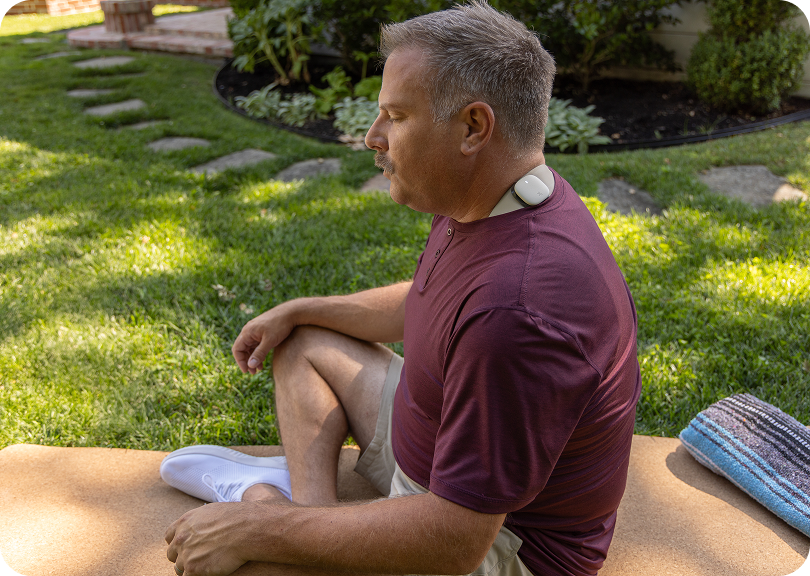How Does Enso Work to Relieve Pain?
Learn how Enso, a pain relief device from Hinge Health, works on your muscles and nerves to help reduce pain.
- Centro de Aprendizaje de Hinge Health
- Artículos
- How Does Enso Work to Relieve Pain?
How exactly does Enso work?
This is one of the most common questions we get about Enso, a pain relief device from Hinge Health. Enso is a drug-free, non-invasive device that delivers pulses — called waveforms — to help quiet the pain response in your nerves.
What Is Enso, Exactly?
Enso is a wearable TENS device: safe and effective, FDA-cleared, and specially designed to relieve muscle pain and soreness. TENS stands for transcutaneous electrical nerve stimulation, which is a fancy way of saying that Enso delivers safe pulses through your skin that work on your nervous system to quiet your pain response.
Enso is small, wireless and portable, with adjustable settings that let you choose an intensity, session length, and waveform that’s right for you.
How Does Enso Relieve Pain?
Your nerves use electrical signals to contract and relax your muscles. Enso produces electrical pulses with unique waveforms to gently stimulate your muscles and nerves and help reduce pain.
Waveforms are patterns of pulses that provide different kinds of pain relief. Enso has three waveforms (deep, gentle, and relaxing) that you can use to personalize your treatment. Enso may also stimulate your body to produce endorphins, which are natural painkiller chemicals.
How Quickly Does Enso Work?
For some people, Enso can provide pain relief in minutes. Others may take a few sessions to see results.
How Effective Is Enso?
In a randomized controlled trial of 36 participants with long-term pain, Enso reduced pain and improved function compared to a control group using a placebo device. After four weeks, Enso users reported an average 54.7% decrease in pain (compared to a 25.3% decrease for placebo device users). People who used Enso experienced an average 2.2x greater pain reduction, twice the improvement in walking speed, and 1.6x the mobility improvement of the control group.
People who use Enso alongside exercise therapy typically see better results than those who do exercise therapy alone. A separate study found that people who combined consistent Enso use with exercise therapy were 2.8x more likely to have improvement in pain at four weeks than those doing exercise therapy alone.
But don’t take it from us. Here’s what Hinge Health Enso users have to say about Enso:
“Enso literally changed my life! I love it. It really works on my lower back pain.”
“It's convenient, it feels good, it works well on my back pain, and it’s easy to use.”
“I truly believe that without my Hinge Health exercises and Enso I wouldn't be able to move the way I can today.”
“Enso has been a life saver! I’m amazed by how much it has helped me!”
Moving With Less Pain
We recommend using Enso before or after a Hinge Health exercise therapy session. Using Enso and also doing exercise therapy may help you move with less pain. With less pain, you may feel more capable or motivated to engage in movement or try more challenging activities. And if there’s one thing we know, it’s that movement is one of the best long-term ways to address pain.
More Effective Pain Relief for Your Organization
For HR and benefits leaders, learn how Enso is taking traditional pain relief to the next level by requesting a demo here.
Get Started With Enso
For Hinge Health members:
To learn more about getting Enso and find out if you're eligible, click here.
Have an Enso, but need to set it up? Click here to open your Hinge Health app.
Already using Enso and still have questions? Talk to a member of our support team. Call 1-855-902-2777 or email help@hingehealth.com.
Read the user manual before using Enso for complete information about indications, instructions for use, warnings, and precautions.
Physical therapy (PT) is for more than just recovering from surgery or injury. It’s one of the top treatments for joint and muscle pain. It helps build strength, improve mobility, and reduce pain. And it doesn't always need to be in person.
Hinge Health members can conveniently access customized plans or chat with their care team at home or on the go — and experience an average 68% reduction in pain* within the first 12 weeks of their program. Learn more*.
Obtén un plan de atención de Hinge Health diseñado para ti
References
Ambrose, K. R., & Golightly, Y. M. (2015). Physical exercise as non-pharmacological treatment of chronic pain: Why and when. Best Practice & Research Clinical Rheumatology, 29(1), 120–130. doi: 10.1016/j.berh.2015.04.022
In a placebo-controlled trial of 36 participants, after 4 weeks, on average. Amirdelfan, K., Hong, M., Tay, B., Reddy, S., Reddy, V., Yang, M., Khanna, K., Shirvalkar, P., Abrecht, C., & Gulati, A. (2021). High-Frequency Impulse Therapy for Treatment of Chronic Back Pain: A Multicenter Randomized Controlled Pilot Study. Journal of pain research, 14, 2991–2999. doi:10.2147/JPR.S325230
Dac Teoli, & An, J. (2019, June 28). Transcutaneous Electrical Nerve Stimulation (TENS). Nih.gov; StatPearls Publishing. https://www.ncbi.nlm.nih.gov/books/NBK537188/
In a randomized controlled trial of 325 participants, after 4 weeks, among users who consistently used their devices. Hong, M., Krauss, J., Wang, G., Cohen, K., Chaisson, C. E., & Gulati, A. (2024). Effectiveness of Hybrid Form Impulse Therapy (HFIT) Compared to Traditional Transcutaneous Electronic Nerve Stimulation (TENS) in Patients with Chronic Low Back and Knee Pain: A Randomized Controlled Trial. Journal of Pain Research, 17, 2417–2430. doi:10.2147/JPR.S461343
Mosley, G. L., & Butler, D. S. (2017). Explain pain supercharged (187). South Australia: NOI.
NHS Choices. (2019). TENS (transcutaneous electrical nerve stimulation). NHS. https://www.nhs.uk/conditions/transcutaneous-electrical-nerve-stimulation-tens/
Ruegsegger, G. N., & Booth, F. W. (2018). Health Benefits of Exercise. Cold Spring Harbor perspectives in medicine, 8(7), a029694. doi:10.1101/cshperspect.a029694
Slavin K. V. (2011). History of peripheral nerve stimulation. Progress in neurological surgery, 24, 1–15. doi:10.1159/000323002
